

We left out of San Juan Puerto Rico and crossed the Sargasso sea and the
abysmal plain to our first station for the last NAAMES cruise. Here
the North Atlantic is our mistress and her secrets we will explore. As
ships crew we find ourselves in some of the most remote locations on this
pale blue dot and few are more remote feeling than the desolate ocean
between Newfoundland and the Azores.
A tumult of rough seas and blustery storms being blown down from the
Arctic. Here is where we will settle in for the next twelve days, here is
where the science happens.
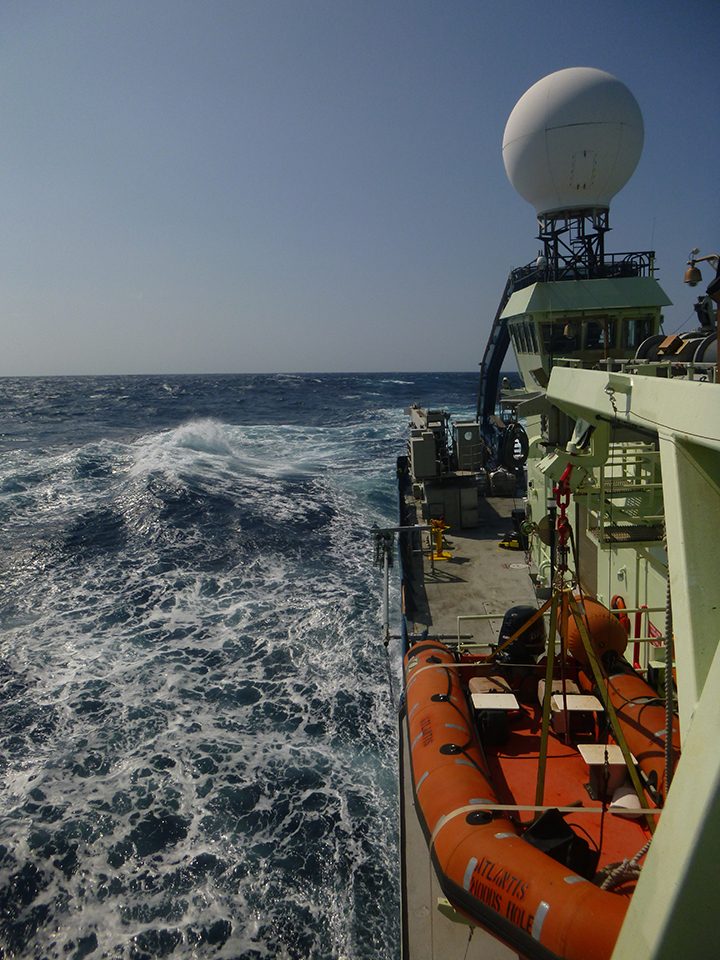
The R/V Atlantis cruising across the North Atlantic Ocean
I am always amazed at the orchestration of these multi platform trips, as
it is beyond difficult to get every piece of gear and every person at a
start point let alone an end.
We live in close proximity for nearly thirty days at a time with a lack of
sleep and long hours but we do it together and we do it for a cause bigger
than our creature comforts. A fact that helps me sleep well at night.
NAAAMES is personally one of my favorite trips and it isn’t for the cold
winds or the confused seas, it is for the crew of people, determined to do
something amazing, coming together as a family. It is my fourth trip out
here and I can safely say that they are in fact family now and could even
pass as ships crew themselves.

Derek Coffman (in front) and other members of the NAAMES scientific crew on the bow of the R/V Atlantis.
Written by Ronnie Whims
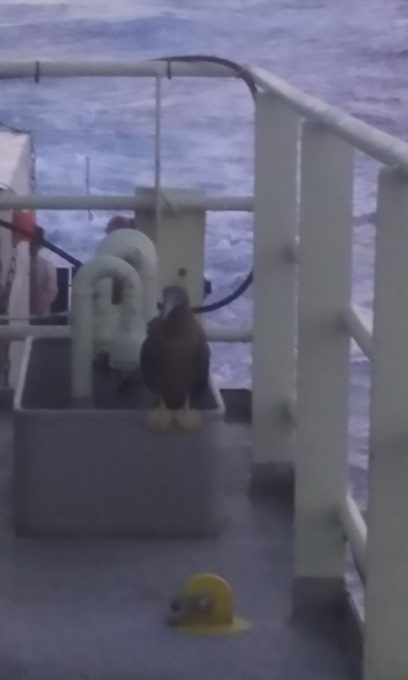
A seabird catching a ride on the R/V Atlantis as it moves north.
Like this young pelagic seabird (let’s call it a juvenile gannet) soon to spend its life at sea, taking a short respite on a chance encounter, I find myself fortunate to have found the research vessel Atlantis (as part of the NAAMES IV campaign). We are still on our trek north to our first station, and as a newcomer to Craig Carlson’s lab I have been learning the various techniques his lab uses to constrain DOM cycling in the surface ocean. My training began by twice daily measuring the incorporation rate of tritiated leucine into heterotrophic bacteria (i.e., bacteria production rate). We are measuring the incorporation rate of tritiated leucine as a proxy for the uptake rate of organic carbon, as dissolved molecules, by heterotrophic bacteria.
Because tritiated leucine is a radioactive compound I have do this work in, essentially, an outfitted shipping container, called the “Rad Van”. No it’s not the “totally rad, man” kind of Rad, but the Rad-ioactive kind of Rad is pretty awesome because it is used to tell us something about the environment. The processing time of surface samples has been fast so far, something like 10-15min twice per day, but we will soon begin full casts to 1,500m twice per day, requiring most of the day to work through what we collect. Reflecting back on life in the Rad Van these last few days, it’s not so bad tucked away in there; it’s isolated and so can be quiet and at times lonely but to know that the isotopes will remain confined to that space is reassuring. As far as changes in bacteria production during this cruise, we expect rates to be high at the surface ocean decreasing with depth and increasing as we work northward into the more productive spring bloom of the North Atlantic. The idea is that the regions of the ocean with higher bacteria production rates are associated with greater organic matter sources on which they had adapted to grow at faster rates.

View of the North Atlantic from the deck of the R/V Atlantis
Though both this work and the NAAMES group are new to me, I am enjoying the work and eager to start looking at data. Many of the PI’s, including the Carlson lab, will participate in subsequently NASA supported cruises as part of the EXPORTS program. And I look forward to continuing this work on as a participant in that program. So perhaps once the trip on the Atlantis has provided its brief oasis, as it has for the juvenile gannet’s migration, I will be ready for the next leg of the journey as part of the Carlson lab.
Written by Brandon Stephens
Rookies at sea
Laura and I come from different geographical backgrounds. I grew up in the hot Mediterranean climate and Laura experienced the rainy climate of northern France. For our next adventure, we were both called to sea for the same purpose: Science. We are not talking about your average kind of research, but what we believe is the most exciting kind: studying ocean-atmosphere coupling onboard of a fully equipped oceanography research vessel: The R/V Atlantis. For us, this is reminiscent of the famous sea explorer and scientist, Jean Jacques Cousteau. To celebrate the end of our gruesome PhDs, we are going to spend the next twenty-five days in the middle of the Atlantic Ocean (aka, in the middle of nowhere) with land nowhere in sight. What a thrilling start of our scientific careers!
As we are writing this blog, our ship is steadily heading at twelves knots over calm and rough waters to reach the northern Atlantic Ocean. It is there that a beautiful annual phytoplankton bloom is starting. In a restricted environment, one would think that this adventure could be overwhelming and overcrowded. But veterans’ tips, everybody’s involvement and their welcoming attitude led to a smooth transition from land to sea. It is also impressive to watch all members follow their daily patterns which look like a beautifully orchestrated dance amid chaotic waves and winds.
As newbies to the sea, we discovered that the periodic rocking of the ship leads to a state of comatose, distracting us from our true purpose; to report hourly that all instruments are working. Luckily, great company (and a few role playing games), (amazing) food, and strong coffee kept us, so far, “sane”.
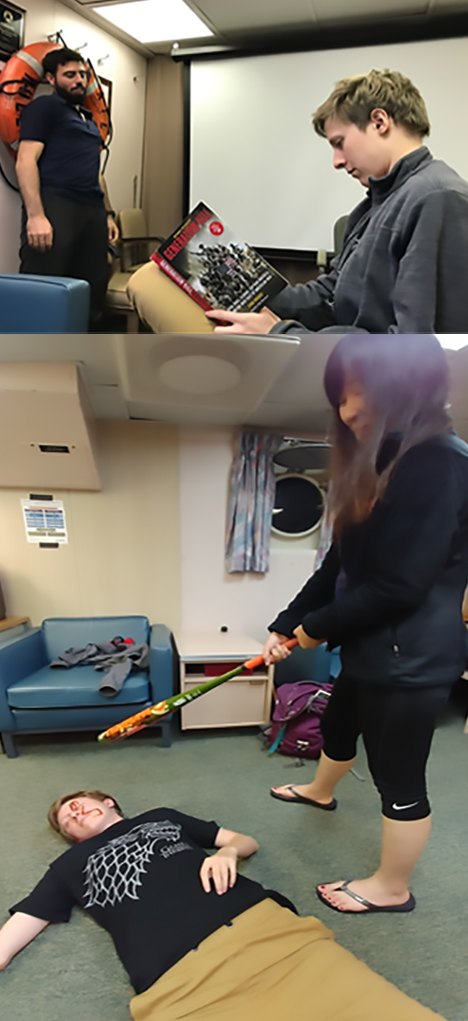
During the transit there is a little time for some fun role playing games. Her murder on the R/V Atlantis: (top) Georges hangs while Laura casually reads “Generation Kill”. (bottom) a few moments later, Laura faces the same fate.
The atmosphere-ocean boundary looks infinite from our vantage point and one might mistake it for simple. Yet the biology that lays beneath the water could affect the physical and chemical properties of tiny particles, created by the breaking of waves, that are lofted into the atmosphere. These particles are too small to be seen by the naked eye but play an important (yet uncertain) role on our climate; aerosols are the seeds on which clouds form. It’s not every day that an expedition of such magnitude happens, but when it did, we were not afraid to get wet.
Written by Georges Saliba and Laura-Helena Rivellini
Gangneung and Daewallyeong, the cities where the Winter Olympics are taking place, have a unique characteristic for precipitation. The cold and dry front from Siberia converges with the moist air of the Korean East Sea to produce stratiform clouds that occasionally precipitate over the PyeongChang province. This condition where the precipitation comes from the east is difficult for forecasters to predict. When the clouds are formed from the west due to low pressure, prediction is difficult because the ground-based radar’s sensing is limited due to the complex orography. Thus, no matter whether snow comes from east or west, it is always hard for meteorologists to forecast weather it in this area. Nevertheless, snow clouds in the region have a particular characteristic, they normally form around 2 kilometers over the sea level.
On February 13th, the D3R Radar from NASA which is located near PyeongChang captured a low elevation snow formation coming from the west which can be seen in the following images.

On the left is D3R RHI Reflectivity image at Ku frequency band, and on the right is D3R PPI Reflectivity image at Ku frequency band.

Compound Weather Radar Map of Korea by KMA.
However, no other operational radars from Korea were able to see the snow coming because of the complex relief where outdoor Olympic venues are located. The image below, taken from the KMA website, shows no snow around the PyeongChang region.
The D3R images allowed KMA staff to predict unexpected snow three hours before it started. Television screen captures taken on this day from the NBC Olympics broadcast (below) show snowfall during the cross country classic spring competition.
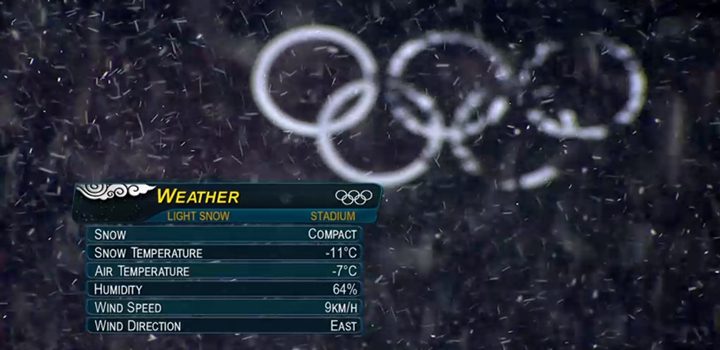
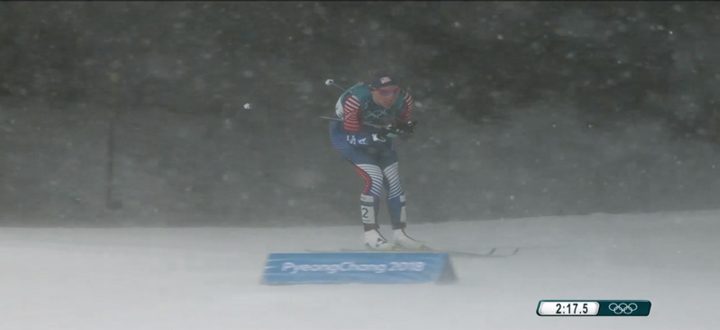
Photos of NBC live streaming the Winter Olympic Games.
On June 5, 2017, a convoy of vans and SUVs drove west from El Paso, Texas, and crossed into New Mexico, headed to a location about 20 miles southwest of Las Cruces. Leaving the pavement behind, we bumped along single-file on dirt roads, marking our way with a trail of GPS “breadcrumbs” and stopping occasionally to let the lagging vehicles catch up. Our destination: a geologist’s wonderland called the Potrillo volcanic field.
New Mexico is home to an impressive number and variety of volcanoes, spread over the state from top to bottom. Among them is the Potrillo volcanic field, a now-dormant region in the New Mexico portion of the Chihuahuan Desert. My team spent 10 days in June 2017 at Potrillo, visiting ancient craters and gently sloping shield volcanoes.
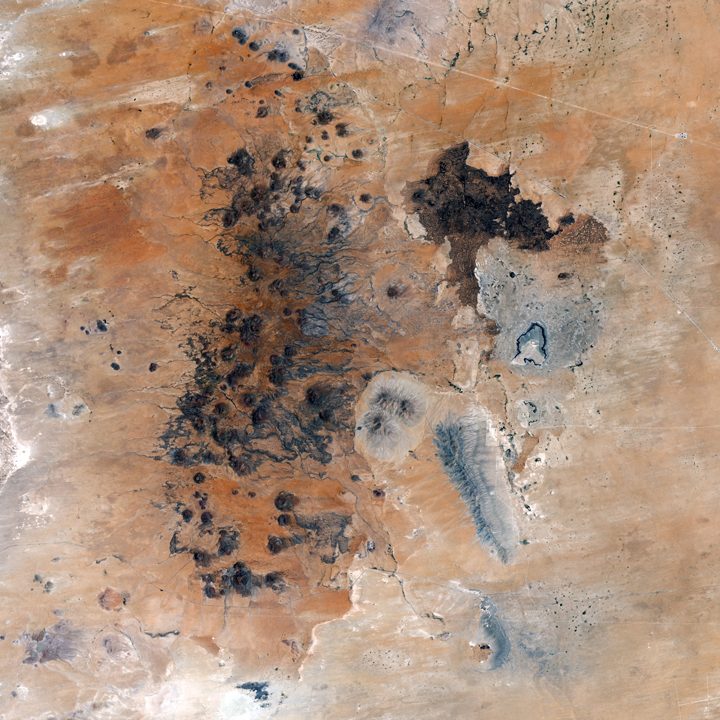
The Potrillo volcanic field. The volcanoes here are monogenetic, which means that when they were active, each one probably had a single eruption. These days, the Potrillo volcanoes are dormant. NASA Earth Observatory image by Jesse Allen.
Our team chose Potrillo because it combines the maar craters formed by explosive volcanism with the shield volcanoes formed by effusive volcanism. This makes it a perfect analog site for testing the kinds of instruments that future explorers might use to investigate volcanic areas on the Moon, Mars and other rocky planets or moons. We brought an array of instruments to map the topography of this terrain and to investigate the mineral composition and chemistry of the volcanic features here.
One of our destinations in the Potrillo volcanic field was the crater called Kilbourne Hole, shown in this fly-over footage taken by our unmanned aerial vehicle. Music in this short video was provided by Killer Tracks. NASA/GSFC/UTEP.
I’m Jake Bleacher from NASA’s Goddard Space Flight Center in Greenbelt, Maryland, and I led this trip. The group included planetary geologists from NASA Goddard; Stony Brook University in Stony Brook, New York; the University of Texas, El Paso; Johnson Space Center in Houston; and other institutions. This team is part of RIS4E, short for Remote, In Situ, and Synchrotron Studies for Science and Exploration, a five-year project led by Timothy Glotch of Stony Brook University. RIS4E is funded by NASA’s Solar System Exploration Research Virtual Institute, or SSERVI, which promotes collaboration linking science to human exploration.

Here, I’m pictured in the black leather cowboy hat I’ve worn on all field excursions for more than 15 years. NASA/GSFC
The Goddard Instrument Field Team, as a part of the RIS4E Project, explores Kilbourne Hole, a maar crater in the Potrillo volcanic field in New Mexico.NASA/GSFC
Helping me document the trip for NASA were Elizabeth Zubritsky, who worked with me on these blog entries, and two members of Goddard’s video team, David Ladd (producer) and Rob Andreoli (videographer).